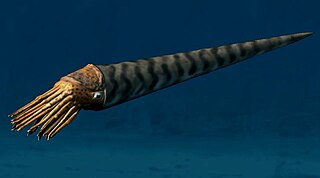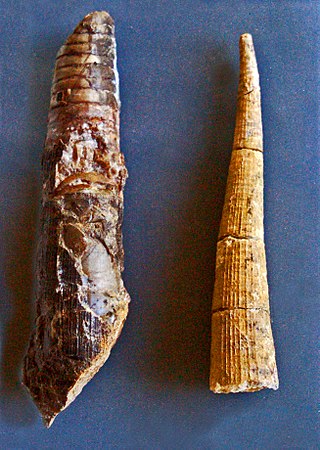
Orthoceras is a genus of extinct nautiloid cephalopod restricted to Middle Ordovician-aged marine limestones of the Baltic States and Sweden. This genus is sometimes called Orthoceratites. Note it is sometimes misspelled as Orthocera, Orthocerus or Orthoceros.
Ungulites is an extinct genus of prehistoric nautiloids. The nautiloids are a subclass of shelled cephalopods that were once diverse and numerous but are now represented by only a handful of species.
Askeatonolucidum is an extinct genus of prehistoric nautiloids. The nautiloids are a subclass of shelled cephalopods that were once diverse and numerous but are now represented by only a handful of species.
Yakutionautilus is an extinct genus of prehistoric nautiloids. The nautiloids are a subclass of shelled cephalopods that were once diverse and numerous but are now represented by only a handful of species.
Eudoceras is an extinct genus of prehistoric nautiloids. The nautiloids are a subclass of shelled cephalopods that were once diverse and numerous but are now represented by only a handful of species.
Zooceras is an extinct genus of prehistoric nautiloids. The nautiloids are a subclass of shelled cephalopods that were once diverse and numerous but are now represented by only a handful of species.
Dawsonocerina is an extinct genus of prehistoric nautiloids. The nautiloids are a subclass of shelled cephalopods that were once diverse and numerous but are now represented by only a handful of species.
Devonocheilus is an extinct genus of prehistoric nautiloids. The nautiloids are a subclass of shelled cephalopods that were once diverse and numerous but are now represented by only a handful of species.

Kionoceras is an extinct nautiloid cephalopod genus included in the orthocerid family Kionoceratidae with scattered worldwide distribution from the Middle Ordovician to the Lower Permian. Kionoceratids are orthocerids with prominent longitudinal ornamentation on their shells, sometimes augmented by secondary transverse ornamentation. Orthocerids are, of course, prehistoric nautiloides with generally straight and elongate shells, mostly with central or subcentral siphuncles.
Cyrthoceratites is an extinct genus of prehistoric nautiloids. The nautiloids are a subclass of shelled cephalopods that were once diverse and numerous but are now represented by only a handful of species.
Kosovoceras is an extinct genus of prehistoric nautiloids. The nautiloids are a subclass of shelled cephalopods that were once diverse and numerous but are now represented by only a handful of species.
Gyroceras is an extinct genus of prehistoric nautiloids. The nautiloids are a subclass of shelled cephalopods that were once diverse and numerous but are now represented by only a handful of species.
Ophionautilus is an extinct genus of prehistoric nautiloids. The nautiloids are a subclass of shelled cephalopods that were once diverse and numerous but are now represented by only a handful of species.
Cornuella is an extinct genus of prehistoric nautiloid. The only known species of Cornuella is C. parva. The nautiloids are a subclass of shelled cephalopods that were once diverse and numerous but are now represented by only a handful of species. Cornuella shell fossils are known from several locations in Missouri and throughout the UK, including Scotland. Cornuella's shell was slightly curved and strongly ribbed. The fossils of Cornuella from Missouri are Cambrian in age. Cornuella likely lived either at the surface or the bottom of the water column. It was likely a grazer.
Metrioceras is an extinct genus of prehistoric nautiloids. The nautiloids are a subclass of shelled cephalopods that were once diverse and numerous but are now represented by only a handful of species.
Eridites is an extinct genus of prehistoric nautiloids. The nautiloids are a subclass of shelled cephalopods that were once diverse and numerous but are now represented by only a handful of species.
Zittelloceras is an extinct genus of nautiloids from the order Oncocerida which are among a large group of once diverse and numerous shelled cephalopods, now represented by only a handful of species.
Belloceras is an extinct genus of prehistoric nautiloid. The nautiloids are a subclass of shelled cephalopods that were once diverse and numerous but are now represented by only a handful of species.
Neptunoceras is an extinct genus of prehistoric nautiloids. The nautiloids are a subclass of shelled cephalopods that were once diverse and numerous but are now represented by only a handful of species.
Stearoceras is an extinct genus of prehistoric nautiloids from the Lower Pennsylvanian - Lower Permian with a fair worldwide distribution.(Kümmel 1964)


